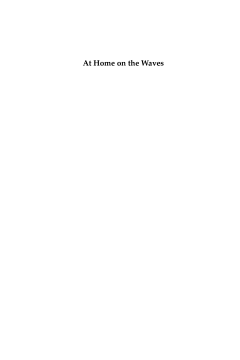
Additional Information
Book Details
Abstract
Contemporary public discourses about the ocean are routinely characterized by scientific and environmentalist narratives that imagine and idealize marine spaces in which humans are absent. In contrast, this collection explores the variety of ways in which people have long made themselves at home at sea, and continue to live intimately with it. In doing so, it brings together both ethnographic and archaeological research – much of it with an explicit Ingoldian approach – on a wide range of geographical areas and historical periods.
“A very ambitious project which engages critically with a timely topic… It crucially brings to the fore the voices and ways of life of those often marginalized or otherwise left out.” • Fiona McCormack, University of Waikato
“Interdisciplinary research is all the rage, but rarely does one find a single volume that manages to weave such varied perspectives and approaches into a fascinating whole.” • Madeleine Hall-Arber, Massachusetts Institute of Technology
Tanya J. King lectures in environmental anthropology at Deakin University, Australia. She is a maritime anthropologist, and her research focuses on the social and ecological implications of environmental policy implementation.
Gary Robinson is a senior lecturer in archaeology at Bangor University, North Wales. His main research interest is the prehistoric archaeology of maritime and coastal communities in western Britain and Ireland.
Table of Contents
| Section Title | Page | Action | Price |
|---|---|---|---|
| At Home on the Waves | iii | ||
| Copyright | iv | ||
| Contents | vii | ||
| Figures | ix | ||
| Tables | xiv | ||
| Foreword | xv | ||
| Acknowledgments | xix | ||
| Introduction — At Sea in the Twenty-First Century | 1 | ||
| Chapter 1 — Moving Beyond the “Scape” to Being in the (Watery) World, Wherever | 17 | ||
| Chapter 2 — Working Grounds, Producing Places, and Becoming at Home at Sea | 34 | ||
| Chapter 3 — Reexamination of Brazilian Mounds: Changed Views of Coastal Societies | 62 | ||
| Chapter 4 — Seamless Archaeology: The Evolving Use of Archaeology in the Study of Seascapes | 79 | ||
| Chapter 5 — Moving Along: Wayfinding, Following, and Nonverbal Communication across the Frozen Seascape of East Greenland | 104 | ||
| Chapter 6 — Drawing Gestures: Body Movement in Perceiving and Communicating Submerged Landscapes | 126 | ||
| Chaper 7 — Exploration of a Buried Seascape: The Cultural Maritime Landscapes of Tremadoc Bay | 144 | ||
| Chapter 8 — Fish Traps of the Crocodile Islands: Windows on Another World | 174 | ||
| Chapter 9 — A Community-Based Approach to Documenting and Interpreting the Cultural Seascapes of the Recherche Archipelago, Western Australia | 201 | ||
| Chapter 10 — Recognized Seaworthy: Resistance and Transformation among Icelandic Seawomen | 231 | ||
| Chapter 11 — “It Is Windier Nowadays”: Coastal Livelihoods and Seascape-Making in Qeqertarsuaq, West Greenland | 250 | ||
| Chaper 12 — Home-Making on Land and Sea in the Archipelagic Philippines | 268 | ||
| Chapter 13 — Fishing for Food and Fun: How Fishing Practices Mediate Physical and Discursive Relationships with the Sea in Cateret County, North Carolina, USA | 286 | ||
| Chapter 14 — Sea Nomads: Sama-Bajau Mobility, Livelihoods, and Marine Conservation in Southeast Asia | 309 | ||
| Chapter 15 — Formal and Informal Territoriality in Ocean Management | 332 | ||
| Afterword — At Home on the Waves? A Concluding Comment | 349 | ||
| Glossary | 357 | ||
| Index | 359 |
